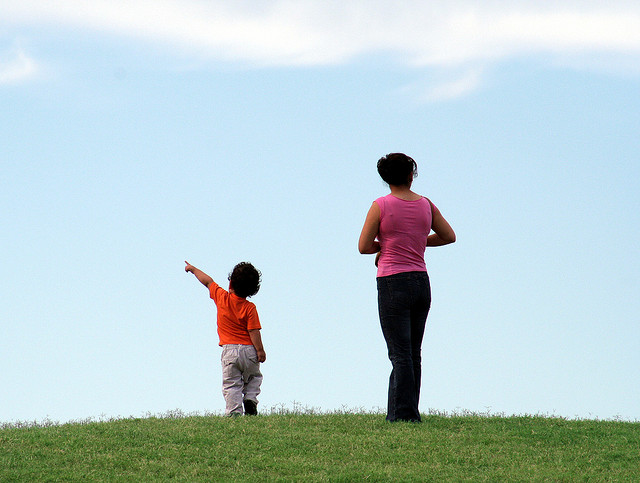I grew up on a small farm in the countryside. My earliest memories include the smell of fresh plowed earth and the sight of brightly colored fresh-picked vegetables in wooden bushels.
I can play some of these memories in my mind like a stockpile of family movies on demand. In one, I am five years old and looking into a large silver tin container filled with water. My grandmother pours a few dozen bright green peppers into the tin, and they tumble around as she adds water from the hose to give them a good rinse. After they bob in the water, she plucks them out and plunges them into a container of water with a little mineral oil added, which makes the fruit shiny before we send it to the local farm stand.
In another, my little brother and I stand in awe at the sight of hundreds of autumn gourds laid out on a white tarp. Gourds are like fingerprints—no two are alike. My grandfather would pick the most exceptional gourds with eccentric colors and shapes and put them aside for us to hold and wonder over. The bulk of the gourds would be shellacked and sent to the local farmer’s markets right before Halloween.
My mother took us for nature walks in the forest behind the farm, and my father grew flowers in greenhouses all year round. The whole family conveyed a high regard for nature in different ways.
Now I live in New York City and have my own child. I want him to have a relationship with the earth like the one my family helped cultivate in me. But how do I do that in the middle of an urban landscape? Our neighborhood includes the smell of sanitation trucks in the high summer heat and the sight of rodents scurrying along train tracks. If I value the earth and our relationship with her, I have to search for things to share with my boy. I have to work hard to make it a priority.
“Have you reckon’d the earth much?…
Stop this day and night with me and you shall possess the origin of all poems,
You shall possess the good of the earth and sun…” ~ Walt Whitman, “Leaves of Grass”
Walt Whitman walked down the streets of our neighborhood and lobbied for the creation of our local park. I try to think of him when we walk through the city, and I wonder what he noticed.
When we walk our boy six city blocks to his school, we point out the cherry blossoms in May and rose of Sharon in August. When we’re at the park, I hope we’ll score a sighting of a pair of red-tailed hawks that live there. (We see them about four times a year.) Wherever we go, my son picks up stones, bark, wood chips, herb leaves and wild berries to put inside his toy cars as passengers. When we have the chance to leave town, we think about a place where he can run barefoot in the grass or build castles in the sand.
At home, we look for art and culture that support our love of the earth. We have a volume of children’s poetry, and each season, we use markers to handwrite a poem from it and post it on the door in his room. Last winter we posted Robert Frost’s poem “Stopping by Woods on a Snowy Evening.” Right now, we have “This is Just to Say” by William Carlos Williams. This fall, I’m going to put up “Autumn” by Emily Dickinson.
Children’s songs also help create a culture of environmentalism. One of my favorites is called “The Earth is Our Mother,” which perfectly captures the essence of loving nature and our role as stewards of its well-being. We also talk about the seasons as they change and sing silly made-up songs about having gratitude for our bath water.
“Give things the dignity of their names…. When we know the name of something, it brings us closer to the ground…. it connects us to the earth… If I walk down the street and see ‘dogwood’, ‘forsythia’ I feel more friendly toward the environment.” ~ Natalie Goldberg, “Writing Down the Bones”
We have a great luxury and a rarity for city dwellers in our parts—a tiny back garden. My husband grows shade plants in a small triangular patch, and I keep an herb garden in pots. I love showing my son how to rub leaves between his fingers and then smell the scent the mint, basil or rosemary leave on his skin. Our little garden gives us the chance to teach our boy the names of plants like hosta and fern, of trees like birch, elm and magnolia and of birds like the cardinal and mockingbird.
When we go farther afield, naming things becomes really fun. We recently went to the city’s botanical garden. While we were looking at native plants, we talked about a limestone ledge we saw and also about Canadian wood nettle, among many other plants. Plant names already sound like poetry, but when they come from the mouth of a toddler, they take on a whole new dimension.
“If we can see our body as a wonder, we also have the opportunity to see the Earth as a wonder, and healing can begin for the body of the Earth. When we go home and take care of ourselves, we heal not only our own bodies and minds, but we help the Earth as well.” ~ Thich Nhat Hanh, “Love Letter to the Earth”
This passage really speaks to me and honestly challenges me. It’s easy to get caught up in the lightning fast pace of the city, and I often do. I love Thich Nhat Hanh’s words because they give me even more reason to slow down and take care of my body. That’s certainly something I want for my son, so I have to note it as an area that I can improve for his sake and my own.
The other day my little boy said to me, “Listen, mama, you hear the bird?” I hadn’t heard the bird, and he made me stop and pay attention. I’d missed an opportunity to connect with nature, but he was already there and created an opportunity for me.
My son is around the same age that I was when I began logging memories. Will he remember calling my attention to the bird in our backyard? Will his earliest memories include any element of communing with nature? I don’t know for sure, but I do know that the related values are so precious that I have to try.
Author: Nina Capelli
Editor: Evan Yerburgh
Image: Flickr









Read 0 comments and reply